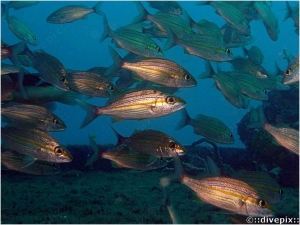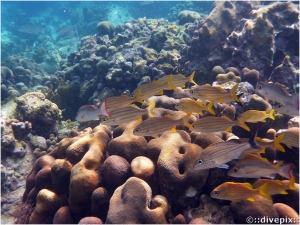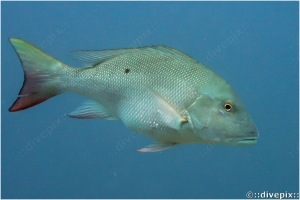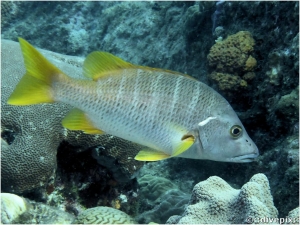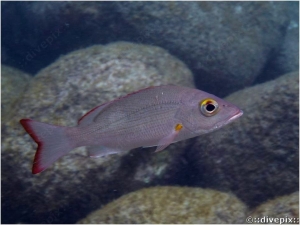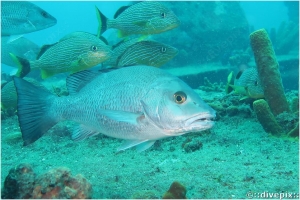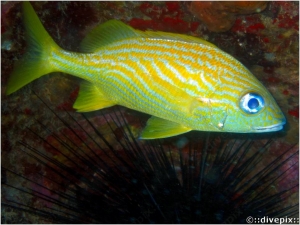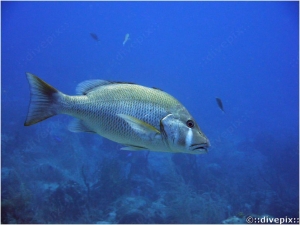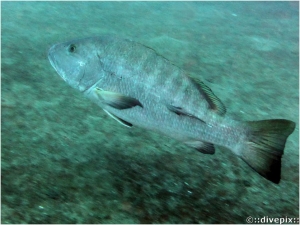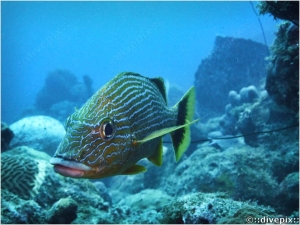




Eric H. Biass
Saturday, 24 November 2012 16:52
Tomtate
| Aspect: | The Tomtate is almost identical in shape to the Smallmouth Grunt with a streamlined body, but only one significant median yellow stripe, others being brown and thinner; dark semi-translucent fins and tail. |
| Population: | Common, in schools. |
| Notable feature: | The name "Grunt" is owed to the sound they can produce under stress. |
| Environment: | Usually found in schools on wrecks and large boulders. |
| Behaviour: | Schools can be easily approched, slowly of course. |
Published in
Grunts
Tagged under
Saturday, 24 November 2012 16:40
Smallmouth Grunt
| Aspect: | Streamilned siver body with five yellow stripes running hrizontally from head to rear, all fins and tail are plain yellow |
| Population: | Common, live in schools often with other species of grunts |
| Notable feature: | Centre yellow line starts from snout, runs across eye to tail, flanked by two parallel lines above and under. The name "Grunt" is owed to the sound they can produce under stress. |
| Environment: | Usually found close to bottom, turning around rocks, boulders and wrecks. |
| Behaviour: | Unbothered by divers. |
Published in
Grunts
Tagged under
Saturday, 24 November 2012 16:27
Mutton Snapper
| Aspect: | Massive silvery body, dorsal half tends to aquire yellowish to greenish hues (sometimes including upper part of the tail fin, which overall tends to be dark brown), with faint darker bars running down its sides down to the grey-pinkish lower body. Often features pale blue markings under the eyes and from eyes to snout. |
| Population: | Common, solitary. |
| Notable feature: | Very similar in shape to Cubera, though smaller, but has V- as opposed to vertical-cut tail fin, but above all features a conspicuousl mid-body dark spot. |
| Environment: | Usually found wandering close to bottom. |
| Behaviour: | Quiet, not bothered by slowly approaching divers. |
Published in
Snappers
Tagged under
Saturday, 24 November 2012 15:52
Schoolmaster Snapper
| Aspect: | Unmistakable combination of heavy silver body and by bright yellow fins all round. |
| Population: | Common |
| Notable feature: | Thick-lipped large mouth, darker dorsal area with pale vertical dorsal stripes. |
| Environment: | Usually found close to bottom, likes hovering above, or resting in, Giant Sponge craters. |
| Behaviour: | Generally co-operative if approached quietly. |
Published in
Snappers
Tagged under
Saturday, 24 November 2012 15:04
Mahogany Snapper
| Aspect: | Light lilac slim body. |
| Population: | Common, often part of schools that mix with other species. |
| Notable feature: | Trailing edge of dorsal and tail distinctively "mahogany" coloured, yellow stain on pectoral fin root. |
| Environment: | Usually found close to bottom, turning around rocks and boulders in search of food. |
| Behaviour: | Easily approached. |
Published in
Snappers
Tagged under
Saturday, 24 November 2012 14:46
Grey Snapper
| Aspect: | Grey heavy body, large scales often look diamond shaped. |
| Population: | Common. |
| Notable feature: | Trailing edge of tail and fins darker. |
| Environment: | Usually found close to bottom, around rocks and on wrecks. |
| Behaviour: | Not too difficult to approach, if done slowly. |
Published in
Snappers
Tagged under
Saturday, 24 November 2012 14:32
French Grunt
| Aspect: | The French Grunt may appear, depending on prevailing light and environment, yellow with blue stripes, but is in fact light silver with yellow stripes. All fins are yellow, including the large tail one. |
| Population: | Common. |
| Notable feature: | Top two lines on either side of dorsal fin tidy and parallel, all others below are diagonal. The name "Grunt" is owed to the sound they can produce under stress. |
| Environment: | Usually found close to bottom in small schools and mixing with other grunts. |
| Behaviour: | The French Grunt is slightly shy, but can be approached slowly. |
Published in
Grunts
Tagged under
Saturday, 24 November 2012 14:09
Dog Snapper
| Aspect: | Grey or light bronze heavy body, darker fins and tail. |
| Population: | Common, solitary. |
| Notable feature: | Characteristic and omnipresent white "teardrop mark" under its eyes. |
| Environment: | Usually found close to bottom, turning around rocks, boulders and wreck structures. |
| Behaviour: | Not too difficult to approach, if done slowly. |
Published in
Snappers
Tagged under
Saturday, 24 November 2012 13:06
Cubera Snapper
| Aspect: | Massive grey-brown body. Could be mistaken for a Mutton Snapper (q.v.), but lacks the latter's mid-body black stain, has much larger lips and stouter tail fin root, while tail fin end is straight-cut (as opposed to V-cut of Mutton Snapper). Another clue is the pectoral fins' white leading spines. |
| Population: |
Rare, solitary. First seen by Divepix inside the Gustavia shipwreck cargo hold in 2008, another specimen was spotted in 2017 around the Franjack hull. |
| Notable feature: | Thick-lipped large and powerful mouth (the Cubera is carnivorous and also feeds on crabs), pale vertical dorsal lines. |
| Environment: | Usually found close to bottom, hiding in wrecks or under rock overhangs. |
| Behaviour: | In spite of its imposing size (specimen featured here being a good 80 cm to one metre-long) remains difficult to approach, and therefore to photograph. |
Published in
Snappers
Tagged under
Saturday, 24 November 2012 12:48
Bluestriped Grunt
| Aspect: | Large yellow-gold body with longitudinal blue stripes (themselves bordered with a darker shade of blue) running from nose to tail. |
| Population: | Common. |
| Notable feature: | Large yellow tail with black vertical bar near tail root. Dorsal fin is also black. Wide, large-lipped mouth. Always appears larger than actually is. The name "Grunt" is owed to the sound they can produce under stress. |
| Environment: | Usually found close to bottom. |
| Behaviour: | The bluestriped Grunt is seemingly unaffected by divers. |
Published in
Grunts
Tagged under



